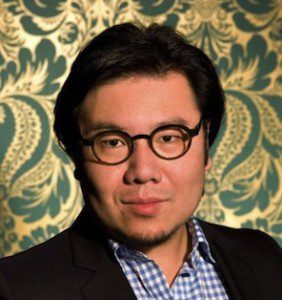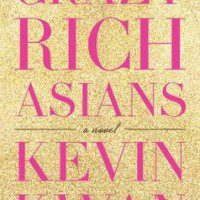I’m not usually drawn to 400-page novels that begin with multiple family trees crisscrossed and stretched across two pages—they tend to remind me of the exhausting Victorians I read in college. What brought me to the checkout line with Kevin Kwan’s first novel, Crazy Rich Asians, was a moment of pure superficiality. I liked the book’s sexy, speaks-for-itself cover—its large, bold pink typography against a gold shimmery surface, showing only the title and author’s name. In many ways, Crazy Rich Asians is about exactly what’d you expect: the lavish lifestyle of Southeast Asia’s one percent, where people talk about the latest Gucci and multi-million-dollar real estate as casually as you and I talk about the weather. But this book is also about much more. It’s a unique, witty, and political analysis of a country that (as Kwan mentions, citing Forbes) in the last decade went from having zero billionaires to 122—third only to the United States and Russia.
The novel follows a thirty-something couple, Rachel Chu and Nick Young, Whole Foods-type academics living in New York City. Rachel, an ABC—American Born Chinese, as the book quickly explains—is invited to spend the summer with Nick and his family in Singapore, and to attend the wedding of Nick’s best friend, Colin Khoo. Although her mother warns her that this trip might not be what she’s expecting, especially since they know very little about Nick’s family, Rachel believes it could mean big things for her relationship with Nick. She accepts his offer with little hesitation.
Before they take off, we get a taste of what’s to come for Rachel in Singapore through a series of snippets of the book’s secondary characters. Kwan skillfully structures brief, introductory chapters that offer portraits of the Young, Shang and T’sien families, all of whom are connected to Nick. We see Astrid, Nick’s cousin who spends weeks in Paris scoping out (and buying out) all the latest couture, and Eleanor, his traditional mother who doesn’t approve of Nick bringing a new “nobody” girlfriend to her home, just name a few.
Not only do we get a taste of the characters that make up these families, but we also get a glimpse into the world that created them, often through dialogue from the characters themselves:
“Well, first of all, you must understand that there are two kinds of Chinese. There are the Chinese from Mainland China, who made their fortunes in the past decade like all the Russians, but then there are the Overseas Chinese. These are the ones who left China long before the Communists came in. If you look at the countries in Southeast Asia—you’ll see that virtually all the commerce is controlled by the Overseas Chinese. Like the Liems in Indonesia, the Tans in the Philippines, the Leongs in—”
When the politics aren’t exposed directly in the text, they’re explained accurately (though often quite cynically) by Kwan in the footnotes: “A tan sri is usually richer than a dato’, and has likely spent far more time sucking up to the Malay royals.”

By the time Rachel and Nick arrive in Singapore, we know that Nick’s family is filthy rich. Rachel, however, doesn’t realize the extent of Nick’s wealth until she visits a Singaporean friend from college, Peik Lin, whose house is described as if it’s modeled after Versailles. Peik Lin and her mother scream like teenagers when they find out that Rachel will be attending Colin Choo and Araminta Lee’s wedding (the wedding of the year!), and they beg Rachel to find out just who exactly Nick’s parents are. When Peik Lin drops Rachel off at Nick’s grandmother’s house—or rather, very large property with a palatial building and multiple Rolls Royces parked in front—she can’t believe it was even possible for someone on the island to own that much land. “Rachel,” she said, “These people are crazy rich.”
Hundreds of pages are filled with descriptions of rooms, ponds, rare flowers, dresses, people gossiping about other people, money, classic art and name brands—an almost endless spectacle of wealth that could easily become exhausting. But because Rachel is as foreign to this world as we are, there are moments of utter shock and discomfort, both for us and for Rachel—like when she learns that a royal gave Nick’s grandmother to two women as a “gift.” It’s crazy and absurd, but it’s fascinating, and these moments transform the novel from mindless entertainment, as if it were a Bravo show on The Real Housewives of Singapore, into a revealing Economist-style feature.
Governments don’t rule these countries—the wealthiest families do. Some would argue the same thing about the United States and Park Avenue CEOs, but what’s missing in Asia is the belief—or even the possibility of the belief—in upward mobility. If your family is Old Money, you’re set forever. If you’re New Money, you’ll never be part of the world that Nick Young grew up in. As Kwan writes, “This crowd made Upper East Side girls look like Mennonites.”
Crazy Rich Asians is just as much a fascinating and voyeuristic look into the lives of the rich and famous as it is a frustrating account of a modern day caste system. But what it’s really about—and what got me through the cringe-worthy scenes—is Kwan’s dozens of thoughtfully crafted characters. Even the richest, most beautiful, love-to-hate people, like Astrid—who throughout the novel has to cope with the knowledge of a cheating husband—are flawed. They’re complex, sad, and lonely—just like any ol’ nobody from any type of family. And there’s nothing superficial about that.




